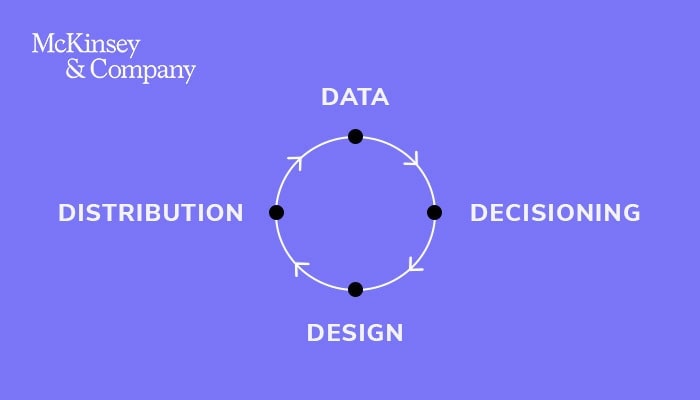Four Takeaways From McKinsey’s Jason Heller on Achieving Personalization at Scale

In his keynote at ActionIQ’s inaugural DynamIQ Exchange conference in New York City, Jason Heller, partner and global lead of digital marketing operations at McKinsey, made a powerful case for personalization at scale and customer data platforms (CDPs) as the core solution to achieve it.
The potential market value of personalization is huge, with $1.7-3 trillion in value at stake, Heller told a packed house. And without decisive action over the next two years, “you will be left behind by your competitors.”
While achieving personalization at scale may seem like a complex and overwhelming objective, Heller broke down the process into what he calls the 4Ds: data, decisioning, design, and distribution. Here, in his own words, are Heller’s insights into how brands can win their share of the trillions of dollars currently up for grabs.
1. Data
Data unification is the fundamental first step, and CDPs are the technology to solve it.
“Unifying your customer data is the first step to being able to run a customer-centric organization,” said Heller. Specifically, data unification means capturing all relevant customer data—behavioral, transactional, and demographic—within a single unified customer record.
By doing so, you can gain the “longitudinal” ability to “engage a particular individual based on their behavior and their attributes and characteristics,” said Heller. This in turn enables two “macro” capabilities:
- Customer acquisition—“Attract and convert higher value customers through paid channels”
- Increased LCV—“Engage existing customers in your own channels to increase lifetime value and retention.”
Because of traditional barriers to data unification, Heller said, “Very few companies are using unified data, analytics and AI to score customers to drive omni-channel experiences across the lifecycle of the customer.”
Fortunately, CDPs solve for this exact problem.
“A CDP sits at the absolute core of your marketing technology stack, at the absolute center of a customer centric, data-driven growth transformation,” says Heller.
2. Decisioning
Piecemeal, one-off analytics efforts are no longer enough. You have to productionalize analytics—and CDPs are an ideal platform for that.
To personalize experiences at scale, you must be able to “create micro segmentation on the fly,” said Heller. In other words, marketers should be able to “come up with an idea, log into a platform, and 30 seconds later be able to execute a campaign,” he says.
And CDPs are proving to be an excellent platform on which to centralize this kind of sophisticated decisioning.
“It wasn’t really the core purpose of having a CDP, but because you have all of your data in one place, and because data science is becoming such a battleground for competitive differentiation, this is one of the additional benefits of having a CDP,” said Heller.
In fact, CDPs are now operationalizing the predictive models that data science teams build. Companies are “ingesting and productionalizing homemade analytics models, plus sending their outputs to final-mile execution tools,” Heller argued.
3. Design
No technology can automate the entire design process. But you CAN scale up with organizational change and the adoption of agile teams.
To design personalized campaigns for a large number of microsegments, Heller said brands need a “content factory” that supports modularization and versioning of creatives. So far, there is no fantastic, off-the-shelf offer platforms to automate versioning, he said. However, he argued you can redesign your teams in a more agile way so that you can speed up the process.
Heller urged brands to adopt an “agile marketing operating model,” which has experimentation and “test-and-learn” in the team’s DNA.
At most marketing organizations today, marketing managers, data and analytics people, channel managers, and content and creative people are all operating in their own teams, explained Heller. Instead, they should consider moving to “co-located, cross-functional—and most importantly, relatively autonomous—operating pods.”
This way of working “takes the cycle time from many weeks, sometimes down two days, sometimes even down to same day for smaller things,” Heller said.
4. Distribution
Last-mile execution tools should send all their engagement signals to your CDP for future decisioning.
“Distribution is the last mile,’ explained Heller, in which “marketing technology platforms actually deliver the experiences to the customer.”
Since CDPs already enable centralized data and decisioning, it makes sense for the last-mile engagement tools to send all engagement data back into the CDP.
A key advantage of this approach is that each of those signals are “integrated back into your models, and pushed back downstream into all of your systems”—to help coordinate the right messages to the right people at the right time, and via the right channels.
Heller ended his keynote with a call to action towards personalization at scale.
“Don’t wait for perfection,” he said. “The best time to plant a tree was 20 years ago. The second best time is today.”
Recommended Next Steps
For more information on Jason’s take on achieving personalization at scale, view his slides from DynamIQ Exchange.
Read more about how CDPs enable personalization at scale and why this matters in the experience economy.





